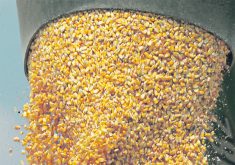U.S. ethanol expansion could open new markets for Canadian feedgrains, says a senior research official.
“I’m thinking there is probably an opportunity for Canada as a supplier of those crops,” said Dorothy Murrell, managing director of the University of Saskatchewan’s Crop Development Centre.
She made the comment after hearing a presentation by Amani Elobeid, ethanol analyst for Iowa State University’s Center for Agricultural and Rural Development, on how ethanol expansion is expected to influence U.S. agricultural markets over the next 10 years.
Elobeid told delegates at an international agricultural research conference hosted by the U of S that a new sophisticated forecasting model shows U.S. ethanol production will top 53 million litres by 2016, up from 18.5 million litres in 2006.
Read Also

Chinese, Indian tariffs take toll on pea prices
The disruption of pea exports from Canada’s largest customers will likely result in slow pea exports for the remainder of the crop year.
That trend has already directly affected 2007 seeding intentions and the impact will continue for many years.
“Corn area is going to go up in the United States and that area is going to be taken out of other crops,” Elobeid said.
Under the Iowa State model, corn plantings are forecast to rise to 92.5 million acres by 2016, up from 78.4 million in 2006. Soybean area will plummet to 68.4 million acres from 75.5 million over the same period.
The model is built on assumptions that include an oil price forecast based on futures market data and U.S. Department of Energy estimates.
But if oil prices were $10 US per barrel higher than projected, it would have major ramifications. Corn plantings would rise a further 21 percent to 112.3 million acres by 2016, while soybeans would fall another 16 percent to 57.2 million acres.
Murrell said if the model’s assumptions are correct, it could bode well for western Canadian feedgrains, especially a high-protein crop such as peas that could fill some of the void left by the smaller U.S. soybean crop.
On the Prairies, where there is no acreage competition from corn, she could easily envision more feed wheat and peas being produced because of higher prices for those alternative feed ingredients.
Elobeid doesn’t know what will happen with a crop such as peas because it wasn’t included in the model, but she is sure livestock producers will switch to other feedgrains in the face of rising corn and soybean prices.
“We actually do see feed wheat use going up,” she said.
Her report also predicts that feed use demand for Canadian wheat will rise to 5.8 million tonnes by 2016 from 4.8 million tonnes in 2007.
Murrell said the study raises questions for Canadian crop breeders, such as whether they should develop wheat for feed and fuel applications instead of food markets.















